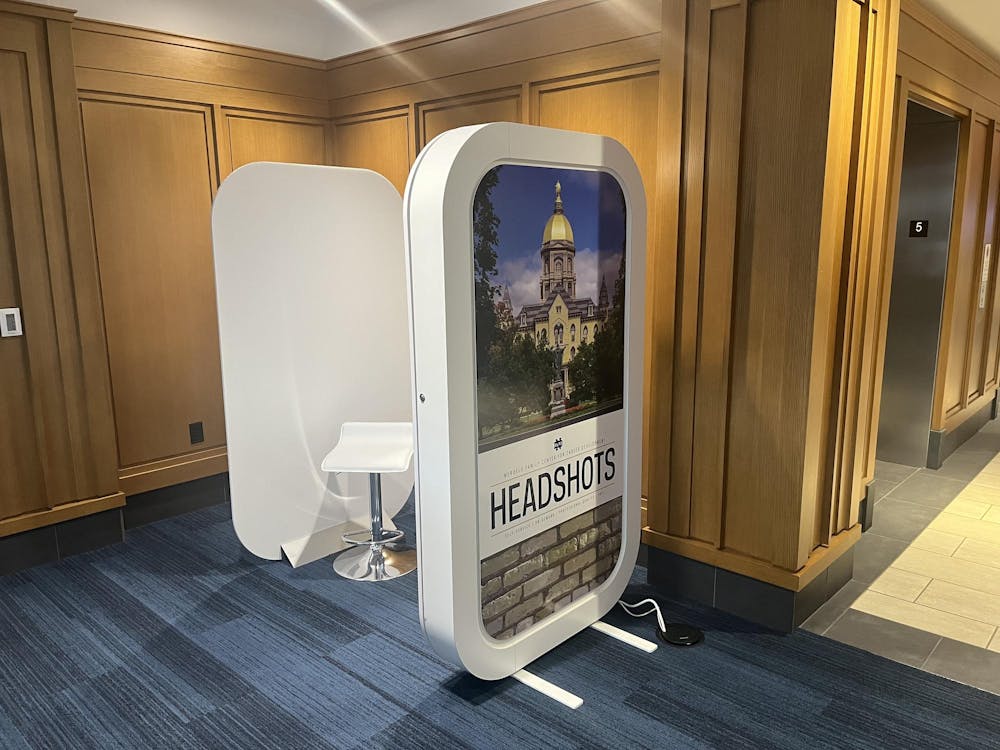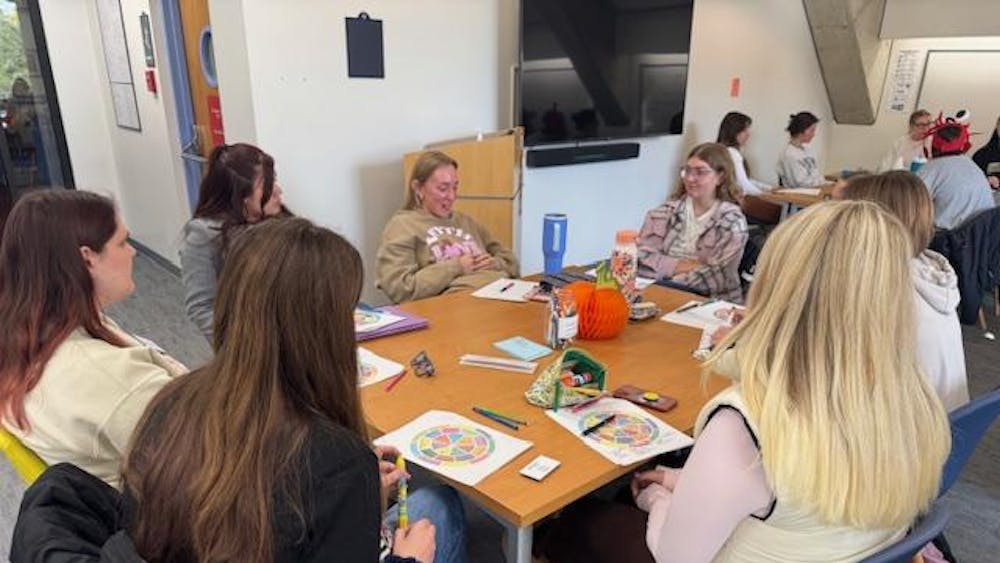When marketing professor Susan Kleiser was a student living in Lyons Hall, she attracted potential employers by mailing them her resume.
Many students nowadays make first impressions on hiring managers through LinkedIn, according to Shawn Freehling, a program manager with the career center who said around 80% of undergraduates use the social media platform.
On a LinkedIn profile, an aspiring professional might display her work history, education, interests, volunteer experience and so on.
“It’s almost like a digital resume that is constantly current,” Kleiser said.
The headshot
Freehling said one component of the LinkedIn profile was important enough that a $15,000 photo booth was recently installed around the corner from the elevators on the north end of the career center — the headshot.
There’s even a video on the career center’s website with Leprechaun Kylee Kazenski, the first female leprechaun to take the field with the Notre Dame football team, that shows how the booth works.
Any member of the University community can use the device for free on a first-come, first-served basis whenever the career center's home on the fifth floor of Duncan Student Center is open. It provides professional-quality headshots in fewer than five minutes.
According to Freehling, students used to be able to register for headshot appointments with the career center during certain windows during the week. For example, one of the career center’s student workers or Freehling himself might be around to shoot headshots on Wednesdays and Fridays from 11 a.m. to noon.
Offering times that worked with everyone’s schedules was impossible, Freehling explained, and the turnaround time for the old headshot service — the period of time before students received their headshots, during which the photos were edited — was a week or two.
After a little bit of research, the career center decided to replace its human-run headshot service with an Iris Air photo booth.
On top of the $15,000 price tag, the Iris Air costs $6,000 to service annually, according to Victor Fisher, a vice president at Iris Booth. The device uses studio-quality lighting and camera equipment. Notre Dame’s Iris Air has a picture of the Golden Dome on it.
Freehling said the booth is operated via touch screen and will even provide the user posing tips. It takes three photos per session, which users can retrieve instantaneously on the internet.
“I know we said less than five minutes, but it’s actually much quicker than that,” Freehling said.
Iris Booth’s website allows users to crop their photos, apply filters, whiten their teeth and correct blemishes or lighting. The career center did a “soft launch” of the booth in early November and started marketing it to campus on Dec. 4.
Smile
Freehling said there’s a time and place for serious headshots, and he understands that some people get nervous when they have to take a formal photo. However, he said he always encourages students to smile in headshots.
“I think smiling in your headshot really helps convey that you’re kind, friendly and you’re somebody that people can envision wanting to work with,” he added.
Kleiser said one’s body language in a headshot matters. She explained body language is a sign of personality, which is part of one’s personal brand. Through a personal brand, Kleiser explained, aspiring professionals can differentiate themselves from other job seekers.
“Are you smiling or are you closemouthed but showing determination or the commitment that you’re a hard worker?” Kleiser said. “Do you have that open-mouth smirk? That might be somebody I would want to go out with after work.”
According to Kleiser, students won’t or shouldn’t get a job because of their LinkedIn headshot — but an unprofessional headshot could be a reason an individual isn’t hired. Kleiser said to take out the suit before trying the University’s Iris Air and to leave that photo from the Southern Cal tailgate for an Instagram or TikTok profile.
“While it may look like you are just one of a million people wearing the same outfit, it’s at least sending the signal that you are professional,” she added.
A LinkedIn headshot reveals information about a job seeker that isn’t typically enumerated on a black-and-white resume, such as one’s skin color, age and gender.
To ensure that their hiring practices are fair, Kleiser said some companies use a “blind” hiring strategy. These companies, for example, might only evaluate a resume after a candidate’s name and college are removed because they believe doing so can help reduce bias.
“Some companies ignore all of it — the picture and personal information is all ignored,” Kleiser said.
Open to networking?
Junior Zoe Griffith, the marketing division director for campus' largest student organization, Student International Business Council, said some students come into the University with a full-fledged resume and LinkedIn profile.
“Other students come in with nothing, and that can be really overwhelming,” Griffith said.
Freehling said he thinks freshman should develop a professional online presence “almost immediately” after they step on campus. He added that the career center provides a slew of resources about building a LinkedIn profile and good LinkedIn habits, and Griffith said these resources have aided her.
“If they have a resource for it, I’ve used it,” Griffith said about the career center and its offerings.
According to Griffith, LinkedIn often is a “starting point” for conversations about her personal journey in interviews or meetings with professionals in other contexts. Perhaps it’s the grocery store where she worked in high school or an experience at a recent internship that becomes an icebreaker.
A well-ordered and interesting LinkedIn profile could help job seekers land an interview, during which candidates will then have enough time to tell the full story of their professional development, Griffith said.
“It looks like a story, but I think, in a lot of ways, it’s kind of the outline of the story,” she said about a LinkedIn profile.
Kleiser said the goal of a brand — whether it’s a personal brand or a brand like Notre Dame — is to provide some form of differentiation from other products in the marketplace. Notre Dame, Duke University and Indiana University all provide the same basic benefit: a four-year education.
“So what does Notre Dame have versus Duke?” Kleiser said.
A company crafts its brand, Kleiser explained, through different elements like a slogan, logo, jingle, color scheme, et cetera. The photos aspiring professionals put up on their LinkedIn profiles, the experiences they chose to share and how they share those experiences are all part of an individual’s personal brand.
If the perception of a brand by consumers and by the ones who are presenting that brand in the marketplace match, it’s a successful brand, Kleiser added.
“Is what I’m presenting what people are seeing?” Kleiser said. “Do they see it the same way?”
Griffith, who is interested in going into brand management, said she also uses LinkedIn to reach out to professionals in that field, including employees of Procter & Gamble, the company she is interning with this upcoming summer.
By connecting with workers at the Cincinnati-based manufacturer on LinkedIn, Griffith explained, she can learn about what employees at the company do and “what those big milestones look like for them,” which helps her plan out and imagine the trajectory of her own career.
Kleiser said she encourages her students to connect with her on LinkedIn because she has a network of professionals from more than two decades teaching in the Dallas-Fort Worth area beyond the typical Notre Dame “haunts,” like all the companies in Chicago. When a friend posts about a job opening on LinkedIn, Kleiser added, she’ll often forward it on to people in her network or the career center.
Freehling said he’ll check LinkedIn before meeting someone new in a professional context just to confirm that “things are correct.”
As with any other social media, Griffith said LinkedIn users might catch themselves endlessly scrolling on the platform and comparing themselves with others.
“I too have been a victim of comparing myself to what my peers are doing,” Griffith said. “And there’s a real danger to that because everyone at Notre Dame is so smart and is on their own path with their career — whether that’s someone who has an internship for two years in the future or you’re someone like me in marketing where you tend to get them maybe even just a month or two before you actually start.”
She added that LinkedIn is a great tool if it’s used for its intended purpose. When she notices herself using LinkedIn for negativity, Griffith said she knows it’s time to close it out.
Freehling did not provide data about how many people have tried the Iris Air so far, but he said its use was “pretty robust.”










